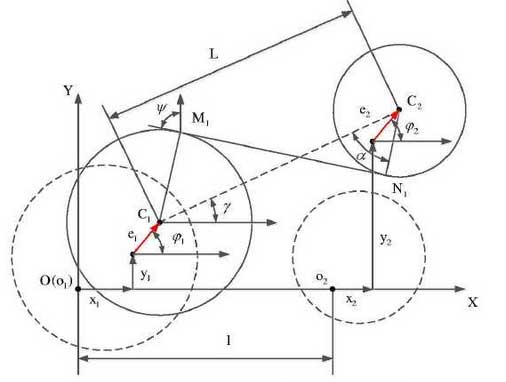At present, the meshing force of gear in most models always follows the theoretical direction of meshing line, ignoring the influence of center distance and meshing state of tooth surface and back on the direction of meshing force.During actual gear engagement, geometric eccentricity, center distance deviation and transverse displacement of the gear will cause the center distance to deviate from the theoretical center distance, thus causing dynamic changes of the direction of engagement force action; due to the existence of side clearance, the engagement state of tooth surface and back may alternate, which will also cause dynamic changes of the direction of engagement force action.The influence of the above factors on the direction of action of meshing force is studied in depth.
The two-dimensional projection model of three-dimensional dynamic model of fixed-axle gear drive on OXY plane is shown in the figure, in order to facilitate analysis, the eccentricity and transverse displacement are magnified in the figure.In the figure, dashed line is the position of two gears at the initial moment, solid line is the relative position of two gears at any time, M1N1 is the engagement line of gears at any time, L is the center distance at any time, A is the engagement angle at any time, and Y is the relative position angle at any time.
As shown, the position vectors R1 and R2 of the centroid C1 of gear 1 and C2 of gear 2 at any time in the fixed coordinate system OXY are:

In the formula, I and j are unit vectors on the fixed coordinate system OX and OY axes respectively, φ1 and φ2 are the angles of each gear, and 1 is the center distance of the drive shaft at the initial moment. Considering the installation deviation during machining and assembly, they can be expressed as:

Where 1S is the theoretical center distance of the gear pair, EA is the deviation of the center distance, Z1 and Z2 are the number of teeth of gear 1 and gear 2 respectively, and M is the modulus.

